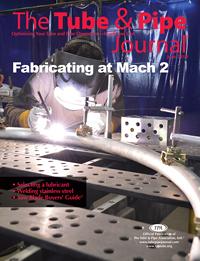- FMA
- The Fabricator
- FABTECH
- Canadian Metalworking
Categories
- Additive Manufacturing
- Aluminum Welding
- Arc Welding
- Assembly and Joining
- Automation and Robotics
- Bending and Forming
- Consumables
- Cutting and Weld Prep
- Electric Vehicles
- En Español
- Finishing
- Hydroforming
- Laser Cutting
- Laser Welding
- Machining
- Manufacturing Software
- Materials Handling
- Metals/Materials
- Oxyfuel Cutting
- Plasma Cutting
- Power Tools
- Punching and Other Holemaking
- Roll Forming
- Safety
- Sawing
- Shearing
- Shop Management
- Testing and Measuring
- Tube and Pipe Fabrication
- Tube and Pipe Production
- Waterjet Cutting
Industry Directory
Webcasts
Podcasts
FAB 40
Advertise
Subscribe
Account Login
Search
A low-volume, high-mix job shop modernizes its operations
Small fabricator maximizes capabilities with equipment and software upgrades, forward-looking perspective
- By Eric Lundin
- May 23, 2019
- Article
- Shop Management
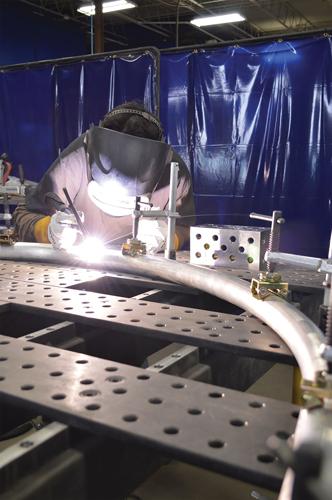
Bending and welding are two main fabrication processes at Alert Tubing Fabricators Inc., Loves Park, Ill. The company augments these with end forming and machining on-site and laser cutting, which it outsources.
“You wouldn’t believe how this place looked when I took it over,” said Kevin Coffey, owner of Alert Tubing Fabricators (ATF) Inc., Loves Park, Ill. Coffey found that a certain territorial mentality and a rigid bureaucracy had established itself in the company, which his father had owned and managed from a distance for many years. The shop had been subdivided by wooden walls (“They had put up buildings inside the building!” Coffey exclaimed), old and corroded raw material was stacked to the ceiling in the inventory area, and the office was overflowing with obsolete paperwork. In the shop, one of the work tables was a sheet of plywood supported by two saw horses. The year was 2013, and merely navigating the front office was a chore considering the number of drafting tables (!) in the engineering area.
“This place was cluttered with equipment,” he said. “They didn’t even have access to all of the machines. To use a tube bender, often they’d have to use a forklift to move two or three other machines to get to it,” he said.
A hands-on type of guy with boundless energy, Coffey arrived on the scene with the can-do attitude and the results-oriented demeanor you’d expect from a former fighter pilot. Although he doesn’t say it, he seems to live by an old U.S. Air Force adage: “Lead, follow, or get out of the way.” He was there to lead, he knew that the Old Guard had to get out of the way, and he was counting on a handful of bright, energetic fabricators to follow.
Rebuilding from the Foundation to the Rafters
ATF’s history goes back to 1958, when Coffey’s father, John Coffey, founded City Welding Sales & Service, a welding gases distributor. Originally located in Morton Grove, Ill., it serviced Chicago and its many suburbs. In John Coffey’s many dealings with customers and other business owners, he spotted an acquisition opportunity in the form of ATF. He acquired the company in 1972 and eventually focused on the fabrication business. In 1980 he handed City Welding Sales off to Kevin’s brother, Shawn, who runs it to this day.
ATF was an unusual company, doing business as a tube fabricator when few tube fabricators existed. In the early days, nearly all of the processes were performed with manual tools, and bends were simple, to say the least. ATF grew and advanced as the industry grew and advanced; John Coffey purchased manually run machines and performed more sophisticated operations as time went on. Even so, the elder Coffey was conservative in his pursuit of equipment. Like many of his generation, he saw value in used equipment and often purchased fleets of machines from competitors that had gone out of business. That strategy worked when technology progressed slowly, and the company was successful for decades.
After two more acquisitions, John Coffey realized that he’d need to consolidate. Maintaining three separate facilities created an unending series of headaches, so he sold two of the buildings and combined all of the operations in the current location. This created a new series of headaches, specifically too much equipment and, more importantly, too many fiefs run by too many chiefs.
A Fast-moving Transition
In addition to flying fighters in the Air National Guard—first piloting the venerable McDonnell Douglas F-4 Phantom II, a fighter so versatile that it served longer than any other, followed by flying the sleek and dazzling General Dynamics F-16 Fighting Falcon—Kevin Coffey clocked nearly 29 years as a civilian airline pilot. At the tail end of his civilian flying career, he moonlighted at ATF, working tirelessly to bring order to ATF’s operations, but it was an uphill battle, he said. As Alzheimer’s disease took its toll on the elder Coffey, the Old Guard at ATF became further entrenched. The transition from father to son was touch-and-go for some time, tangled in legalities, but when Coffey finally was able to take control of the company, he took thorough control of it.
His first goal was simple: He intended to upgrade all of the company’s capabilities—bending, end forming, machining, and welding. He knew that in an era in which software and control systems become more capable every day, it’s impossible to keep up with the competition—or surpass the competition—by buying obsolete machines. Under his tenure, the company would either invest in the latest equipment or, at the very least, upgrade old equipment. The company also would invest in the necessary software to modernize its capabilities and operations.
He started by selling off a handful of old bending machines and gutting the mess in the plant. Next, he upgraded two of their four tried-and-true benders, Pines models, built decades ago.
“I had them completely overhauled,” Coffey said. “They got new motors, new actuators, digital controls, and new wiring,” he said, effectively combining the strengths of two eras: well-built, robust machines from decades ago augmented with the latest hardware. These machines handle the bulk of the basic bends, doing much of the day-to-day work, in diameters from ¾ to 3 inches, with much better accuracy and productivity than they achieved before they were updated.
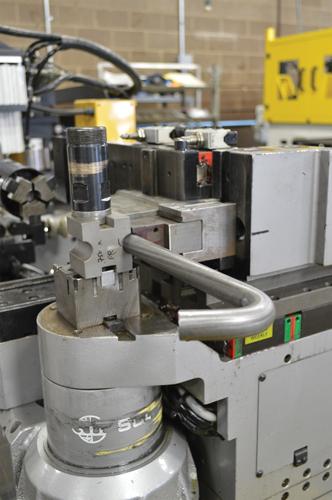
Short-radius bends, simple or compound, aren’t difficult for a fabricator outfitted with the relevant bending technology.
“The bend accuracy is in tenths of a degree,” Coffey said.
He coupled these initiatives with new equipment purchases. He invested in three rotary draw all-electric tube benders, SOCO models SB-32, SB-52x10A, and SB-63AUTO. With model names that match the maximum diameters they bend—32, 52, and 63 millimeters, corresponding to 1.25, 2, and 2.5 in., respectively—they have the precise bending control associated with servomotor technology. The SB-32 and SB-52 machines do both right- and left-hand rotary draw bending and push bending. The 2-in. model has 10 axes of control, and the 1.25-in. machine has eight, enabling tight-radius compound bends, with or without mandrel.
The homemade work table, the sheet of plywood teetering on a couple of saw horses, is long gone. The company welds a lot of assemblies, many of which are mind-bogglingly complex. It uses a BuildPro® modular fixturing system, which is based on a steel work surface, 5⁄8-in.-thick plate nitrided for corrosion and spatter protection. It has a grid of 5⁄8-in.-dia. holes laid out in 2- by 2-in. spacing to accommodate components to build temporary welding fixtures. The welder uses brackets, pins, stops, spacers, and clamps that are secured to the table by ball-lock bolts to build essentially any configuration imaginable.
Band saws, chop saws, roll benders, end forming machines, an orbital welding machine, and a five-axis machining center round out the capabilities, making ATF a one-stop shop. For parts that need laser cutting and forming, ATF Inc. uses Target Laser in nearby Rockford, Ill.
Brains, Not Brawn
While Coffey was busy getting rid of the interior walls, excess inventory, drafting tables, the rickety homemade workstation, and the mentality that created this environment, he retained the two things he needed to make the company thrive: keen minds and gusto.
“We don’t make much in really large volumes,” said Kyle Rogers, quality manager. “We have repeat orders in the hundreds of parts, and a few in the realm of 1,000 parts at a time, with maybe one bend, a bead, or a braze-on fitting,” he said.
A large proportion of the jobs are prototypes, each with its own unique and complex specifications.
“We do a little bit of everything here,” Coffey said. Reading a print, using a micrometer and CMM, and having a thorough understanding of dimensions and tolerances and a natural penchant for problem-solving aren’t skills that ATF builds; they’re skills that ATF needs.
“The company has been making some parts for 20 or 30 years, but we see new parts every week,” Rogers said. A new part could be just about anything, considering the many markets the company serves. It might be a production part for a combine harvester, a prototype part for a system bound for a near-Earth orbit, or an order of 10 pieces needed to build a stand to test a rocket motor. Because the part volume often is absurdly small, the company has to excel at turning a profit on just a handful of parts, day in and day out, week in and week out, all year long. This is why the company relies on brainpower.
“Not many fabricators in the Chicago area, let alone Rockford, can do what we do,” Coffey said, describing a combined metropolitan area of more than 10 million people. “It’s hard to teach anyone what we do. We try to recruit people who are new to the industry so we can train them from Day 1,” he said. Savvy enough to know who to keep when he was cleaning house, Coffey leads an organization made up fabricators who spend more time solving problems than manufacturing parts.

Even a simple weld looks great when done well. Because ATF does a little bit of everything, any customer can benefit from the company’s many certifications.
Even a simple matter, such as introducing the concept of ISO 9001:2015 certification and more recently AS9100D certification, a quality system for aviation, space, and defense work, helped Coffey determine who would stay and who would go.
“Some of the employees said that ISO would cut into our business by raising costs,” Coffey said. It’s true that developing a management system that standardizes processes, harmonizes operations, adds a layer of oversight, and needs continuous maintenance does require additional resources, but Coffey found the resistance, and the rationale behind it, to be laughable. It’s one thing to make good parts consistently; it’s something else to advertise to your customers, and your potential customers, that you have a certified management system in place that provides a foundation for making good parts consistently.
These are modern times, and certifications are modern business concepts. Coffey knew that achieving ISO and AS certifications would open far more doors than it would close.
A Powerful Power Trio
After dealing with the inertia that was sapping the company’s ability to progress, while taking care to retain the dynamic members of the staff, recruit new ones, and upgrade the equipment, what’s left? In military parlance, command and control, or C2. According to Air University, www.au.af.mil, an official USAF website, command and control “encompasses all military functions and operations, giving them meaning and harmonizing them. [It] is not the business of specialists … because command and control is fundamentally the business of the commander.” Additionally, it is “the means by which a commander recognizes what needs to be done and sees to it that appropriate actions are taken.”
Getting control over every step, from quoting to shipping, was one of Coffey’s primary concerns. He focused closely on getting reliable, accurate bend data (using good inputs); verifying the dimensions after the bends were made and assemblies were completed (measuring the outputs); and process flow (tracking each part’s progress).
Inputs. An old programming adage warns that a computer program’s output is only as good as its input, but “garbage in, garbage out” also applies to any production process. For many of the tube fabrication projects at ATF, bend data isn’t entered, which introduces the possibility of a data entry error, or “garbage in.” Instead, whenever possible, tube data is imported. For this step, the company uses VTube-Step from Advanced Tubular Technologies Inc.
Developed to use X, Y, and Z data to build solid models, the software also can import tube models from any solid modeling package and use that information to map the tube’s centerline and develop the X, Y, and Z data. It also unbends the model to determine the raw material length and can send the bend data to the bending machine in the Supravision format.
This helps improve speed and accuracy when making new parts, and it helps in reverse-engineering existing parts as well. No sense in making new files for an old part if you can just copy the old part.
Measurements. A coordinate measuring machine (CMM) assists with inputs for reverse engineering and provides quite a bit of the company’s quality control capability. Equipped with a laser head for noncontact measurements that are extremely precise, it’s a key tool in verifying the dimensional integrity of nearly every component or assembly that ATF produces.
Rogers certainly uses his share of micrometers, gauges, and check fixtures, but the CMM is the heart of the company’s quality efforts.
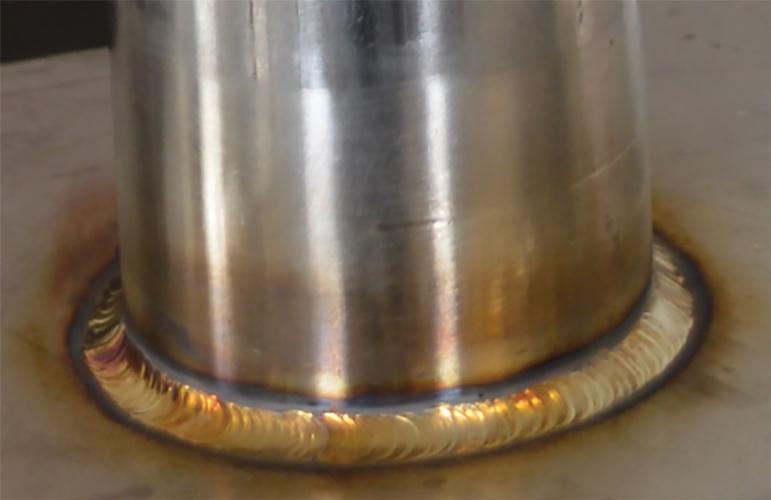
Even a simple weld looks great when done well. Because ATF does a little bit of everything, any customer can benefit from the company’s many certifications.
Of course, a CMM takes measurements, but then what?
“It interfaces with software that creates a digital check fixture,” Rogers said. “It then compares the tube’s dimensions to the digital check fixture and highlights any discrepancies.”
Organization and Oversight. Making parts and assemblies and verifying that they conform to their respective prints sounds like the role of a small manufacturing firm, but these are just the essential steps of making products. Estimating parts accurately; establishing, documenting, and maintaining the processes that are needed to make conforming parts consistently; overseeing the flow of parts through the facility; and coordinating all of the activities on the shop floor are some of the many factors that go into making a profit. For this, Coffey relies on E2 Shop System, an enterprise resource planning (ERP) program from Shoptech™ Software. It ties together the various steps needed to bid a job and, if the customer accepts the quote, the software checks the raw material inventory, starts the paperwork, tracks the job, and helps with the accounting.
Entering job data in E2, for a part or an assembly, is a matter of defining the material, entering each manufacturing step, and estimating machine times (or copying such information from previous routings). The software uses costing estimates and calculates the selling price to determine profitability. To proceed, the software uses the accumulated information to generate a quote for the customer’s review and, if it’s accepted, it generates a job number and creates the necessary documentation to initiate the job, including prints and inspection paperwork. Bar codes on the traveler allow each employee and members of the quality department to scan the paperwork as the job progresses, which updates the job’s status in the ERP system in real time.
“Every operation and every inspection get scanned,” Coffey said.
The program provides shop oversight, too. A virtual white board shows machine status and helps to eliminate bottlenecks. An integrated quality module allows the user to track nonconformances, corrective actions, gauge maintenance, and key performance indicators.
Still, “garbage in, garbage out” applies. The software wouldn’t be successful without 100 percent participation on the part of the people using it.
“The staff did a good job in implementing AS9100D,” Coffey said, referring to the quality standards specific to organizations that support aviation, space, and defense. At the risk of oversimplification, Coffey found that the software shouldered quite a bit of the burden in getting certified. The software can’t do the work, but it provides a lot of the functions and processes that have to be done to comply with ISO and AS requirements, in effect guiding the management team to its goal.
“Our auditor said that this software can help a shop clear 95 percent of the hurdles it encounters on its way to certification,” he said.Coffey credits Rogers for taking the lead in compliance or certification to several standards, including the Defense Federal Acquisition Regulation Supplement (DFARS), International Traffic in Arms Regulations (ITAR), the National Institute of Standards and Technology (NIST) Special Publication 800-171, and AS9100D. He also was instrumental in streamlining the paperwork, both internal and external.
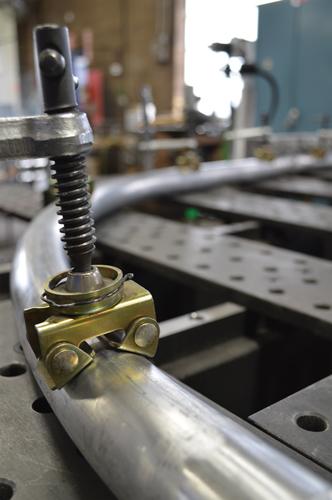
ATF’s welders used to weld angle and other various leftover lengths of steel to a worktable to create each weld fixture from scratch. It worked, but it was cumbersome and time-consuming. A modular worktable with a variety of blocks, pins, spacers, and clamps has been a tremendous help in simplifying and speeding up the fixturing process.
“Kyle put in a lot of hours in setting up the procedures we needed for AS9100D, which is more restrictive than ISO 9001:2015,” he said. “He also did a lot to simplify the paperwork. Order entry, routings, welding procedures, the paperwork we use to communicate with our customers—you name it, he updated it.” NIST 800-171 compliance required 126 pages of documentation to show the company’s hardware and software met the cybersecurity standard for integrity in controlling unclassified information.
“He organized everything so well that anyone can find the information they need at a glance,” Coffey said.
What Does a Pilot Know About Manufacturing, Anyway?
It’s not difficult to understand Coffey’s view on running the company. When two pilots face off, flying experience and a knack for deceptive tactics are two primary factors that determine which one will be victorious, but these aren’t the only factors. They rest on the aircraft’s performance characteristics and the capabilities of its radar and weapons systems.
In other words, a good airplane maximizes a pilot’s skill. Likewise, an experienced fabrication staff can beat the competition only when it has a support structure, in the form of established processes, capable equipment, and modern software, that leverages the staff’s knowledge.
On the surface, changing careers from piloting aircraft to manufacturing parts, whether those parts are for aerospace applications or otherwise, doesn’t seem like a natural transition. You wouldn’t think using combat maneuvers to outfly and outgun an adversary and bringing in a planeload of passengers safely on a stormy night with a strong crosswind would have much to do with forming a tube.
Actually, they do.
Learning to fly means mastering the systems and subsystems that provide propulsion, control, communication, and, in the case of military aircraft, weaponry. Pilots have to be well-versed in the principles that govern all of the systems, whether they are mechanical, hydraulic, pneumatic, electric, or electronic, and pilots have to understand how they work together to make the aircraft do the pilot’s bidding. Understanding the systems means having a knowledge about the many subsystems, assemblies, subassemblies, and components that make up the aircraft.
Pilots also have to keep in mind all sorts of performance information, such as the aircraft’s acceleration, top speed, and climb rate—which vary as they deplete the fuel load, lightening the aircraft—in addition to the service ceiling, the radar and missile capabilities, and just how hard they can push the plane in combat maneuvers (how much stress the airframe can handle, measured in multiples of the force of gravity, or g). Successful combat pilots have to understand the systems, think like a mechanic, and fly like a demon.
They also have to be well-versed in the performance characteristics of the adversary’s aircraft so they know how it performs and how to exploit its weaknesses.
In short, a pilot in a McDonnell Douglas F-4 Phantom II who has no fear of a pilot flying a MiG-23 Flogger is the equivalent of a manufacturer who has no fear of making a complex welded assembly of bent and formed tubes, one that has to pass a rigorous dimensional inspection before it gets shipped out, and one that has to pass an equally critical inspection by the customer when it shows up at his receiving dock.
In a nutshell, that describes Kevin Coffey and the staff at ATF.
About the Author

Eric Lundin
2135 Point Blvd
Elgin, IL 60123
815-227-8262
Eric Lundin worked on The Tube & Pipe Journal from 2000 to 2022.
About the Publication
Related Companies
subscribe now

The Tube and Pipe Journal became the first magazine dedicated to serving the metal tube and pipe industry in 1990. Today, it remains the only North American publication devoted to this industry, and it has become the most trusted source of information for tube and pipe professionals.
start your free subscription- Stay connected from anywhere

Easily access valuable industry resources now with full access to the digital edition of The Fabricator.

Easily access valuable industry resources now with full access to the digital edition of The Welder.

Easily access valuable industry resources now with full access to the digital edition of The Tube and Pipe Journal.
- Podcasting
- Podcast:
- The Fabricator Podcast
- Published:
- 04/16/2024
- Running Time:
- 63:29
In this episode of The Fabricator Podcast, Caleb Chamberlain, co-founder and CEO of OSH Cut, discusses his company’s...
- Trending Articles
Zekelman Industries to invest $120 million in Arkansas expansion

3D laser tube cutting system available in 3, 4, or 5 kW

Corrosion-inhibiting coating can be peeled off after use

Brushless copper tubing cutter adjusts to ODs up to 2-1/8 in.

HGG Profiling Equipment names area sales manager

- Industry Events
16th Annual Safety Conference
- April 30 - May 1, 2024
- Elgin,
Pipe and Tube Conference
- May 21 - 22, 2024
- Omaha, NE
World-Class Roll Forming Workshop
- June 5 - 6, 2024
- Louisville, KY
Advanced Laser Application Workshop
- June 25 - 27, 2024
- Novi, MI
























